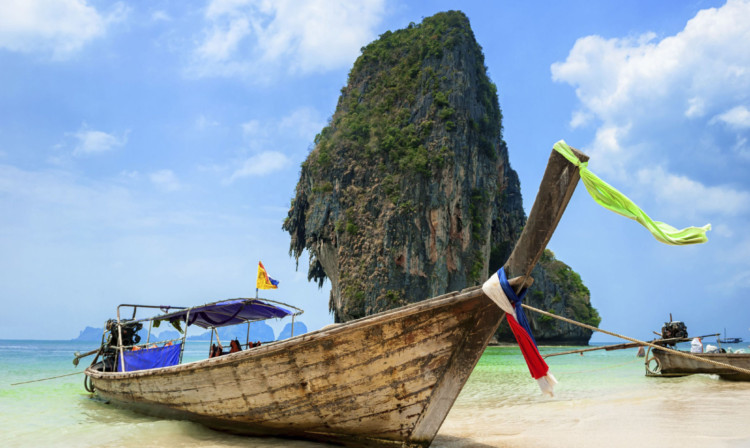
Over 800,000 Britons enjoy breaks in Thailand every year, and 16 million come from across the world.
It’s easy to see why. This is a breathtaking country, with Buddha statues the size of skyscrapers and miles of stalls selling the tastiest fresh fruit and veg anywhere.
Historians reckon Thailand pulled off an almost-unique trick by not being colonised by anyone else over the years! That, of course, means that much of what you see here is centuries old or even older and unspoiled. Not Westernised, in other words!
At times, Thailand can feel like another planet, and you’ll definitely want to take loads of pictures. It’s a riot of colour, noise and atmosphere.
Many, of course, head for spots like Bangkok, with endless bars and restaurants, neon lights, exotic food and plenty of bargains in the stores. This time of year, in fact, is a good time to head there. While our weather gets chillier and the sun takes his winter break, spring and summer are just popping up in Thailand. In most regions, the monsoons and rainy season are gone.
The locals make great play of the fact that their country on the world map looks like an elephant’s head, and these wonderful creatures are important here. November, in fact, sees the Elephant’s Breakfast, when the stars with the trunks give amazing displays at, you guessed it, Elephant Stadium! The elephants re-enact battles of the past, and as you’ll gather, they’re very clever animals if you prefer a more laid-back ride on an elephant’s back, out into the suburbs, that can be arranged, too.
It’s said to be surprisingly smooth and not nearly as bumpy as you may fear!
Just a few hours from the capital, the country’s East Coast, you’ll discover the heavenly beaches that have made Thailand such a tourist magnet. You’ll get a bit of a sinking feeling at first, though they have discovered a wealth of oil beneath the earth here, and refineries are popping up like nobody’s business. That’s the main reason why so many tourists get on a ferry next, and head to the many idyllic islands, where you’ll never want to leave.
Ko Si Chang and Ko Samet have long been getting the thumbs up from sun worshippers, although they’ve become so popular that some now head for the smaller, remote islands, where you may be lucky enough to get an entire beach all to yourself.
With golden soft sands and turquoise waters, with a little bar or diner never too far away, you’re also close enough to the border to go over into Cambodia if that idea sounds attractive.
If the Land of a Million Rice Fields sounds more like your cup of tea, then take the train to the north, approaching the border with Burma and Laos. You won’t see any sand or sea here, but you can feast your eyes on another astonishing landscape.
The Doi Khun Tan National Park looks unspoiled, and the ancient palaces and temples are a joy to behold as your guide tells you about the peoples who lived here over 1,000 years ago.
One of the tourist highlights of any trip to this part of the world is to set eyes on the gigantic Buddha statues. The tallest is still being planned, with India vowing to erect a 500-foot one, but there are plenty at 300 feet or more in Thailand, including the stupendous Lord Buddha in gold, towering over an audience of smaller Buddhas.
You’ll also see massive statues of Kuan Yin, who’s not as well-known or well-loved as Buddha yet but is a fast-growing cult among Thais.
Sukothai Historical Park is also in the north, and this is where you will see the ruins of Wat Mahathat, a collection of statues so impressive that visiting Presidents, Emperors and Kings have stood staring, jaws dropped.
There are almost 200 separate items, some gigantic, some tiny, spread over 40 miles or so, and you won’t be at all surprised to learn it is now an official World Heritage Site.
Bangkok and Chiang Mai are the big centres, and they are also where you’ll find the widest range of foods. It’s only polite to give the local food a try, and you probably won’t go straight back to fish and chips!
Duck or chicken are recommended, and Thais mostly eat with a fork in the left hand and a spoon in the right. The tradition is to cut morsels of all foods so small, knives are rarely needed at the table.
You’ll be handed chopsticks for noodle dishes, though, but for sticky-rice meals it is customary to eat with the fingers of your right hand.
Thankfully, that is about the only custom you may need to get used to in Thailand and we defy you to come here once and not make a return trip.

Enjoy the convenience of having The Sunday Post delivered as a digital ePaper straight to your smartphone, tablet or computer.
Subscribe for only £5.49 a month and enjoy all the benefits of the printed paper as a digital replica.
Subscribe